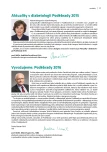Cholesterol metabolism in patients with type 2 diabetes
Authors:
Michal Vrablík; Eva Tůmová
Authors‘ workplace:
Centrum preventivní kardiologie III. interní kliniky 1. LF UK a VFN Praha
Published in:
Vnitř Lék 2016; 62(3): 189-194
Category:
Reviews
Overview
Diabetic dyslipidemia is a complex disorder associated with changes in lipid metabolism, which must be considered during care of the diabetic patient. Type 2 diabetes mellitus is a disease associated with a number of macrovascular and microvascular complications and it is necessary to treat the patient with regard to the possibility of developing these disorders. Prevention of cardiovascular complications is one of the most important factors of diabetes care, because cardiovascular diseases are among the leading causes of morbidity and mortality in patients with diabetes mellitus. The risk of developing atherosclerotic changes is significantly higher in diabetics in comparison with people without diabetes, which is mostly due to the differences in the plasma lipid metabolism and development of typical diabetic dyslipidemia with high atherogenic potential. Treatment of diabetic dyslipidemia as well as prevention of cardiovascular events is based on adherence to lifestyle changes, that have a positive effect on diabetes itself, and a suitable pharmacotherapy selected to achieve target plasma lipoprotein levels while affecting their quality.
Key words:
diabetes mellitus – diabetic dyslipidemia – insulin resistence
Sources
1. Third Report of the National Cholesterol Education Program (NCEP) Expert Panel on Detection, Evaluation, and Treatment of High Blood Cholesterol in Adults (Adult Treatment Panel III) final report. National Cholesterol Education Program (NCEP) Expert Panel on Detection, Evaluation, and Treatment of High Blood Cholesterol in Adults (Adult Treatment Panel III). Circulation 2002; 106(25): 3143–3421.
2. Juutilainen A, Lehto S, Rönnemaa T et al. Type 2 diabetes as a “coronary heart disease equivalent”: an 18-year prospective population-based study in Finnish subjects. Diabetes Care 2005; 28(12): 2901–2907.
3. Harris MI. Health care and health status and outcomes for patients with type 2 diabetes. Diabetes Care 2000; 23(6): 754–758.
4. Reiner Z, Catapano AL, De Backer G et al. (European Association for Cardiovascular Prevention & Rehabilitation). ESC/EAS Guidelines for the management of dyslipidaemias: The Task Force for the management of dyslipidaemias of the European Society of Cardiology (ESC) and the European Atherosclerosis Society (EAS). Eur Heart J 2011; 32(14):1769–1818.
5. Austin MA, Breslow JL, Hennekens CH et al. Low-density lipoprotein subclass patterns and risk of myocardial infarction. JAMA 1988; 260(13): 1917–1921.
6. Enkhmaa H, Ozturk Z, Anuurad E et al. Postprandial Lipoproteins and Cardiovascular Disease Risk in Diabetes Mellitus. Curr Diab Rep 2010; 10(1): 61–69.
7. Hsieh J, Hayashi AA, Webb J et al. Postprandial dyslipidemia in insulin resistance: Mechanisms and role of intestinal insulin sensitivity. Atheroscler Suppl 2008; 9(2): 7–13.
8. Rivellese AA, De Natale C, Di Marino L et al. Exogenous and endogenous postprandial lipid abnormalities in type 2 diabetic patients with optimal blood glucose control and optimal fasting triglyceride levels. J Clin Endocrinol Metab 2004; 89(5): 2153–2159.
9. McPherson R. Remnant cholesterol: “Non-(HDL-C + LDL-C)” as a coronary artery disease risk factor. J Am Coll Cardiol 2013; 61(4): 437–439.
10. Lusis AJ, Mar R, Pajukanta P. Genetics of atherosclerosis. Annu Rev Genomics Hum Genet 2004; 5: 189–218.
11. Kearney PM, Blackwell L, Collins R et al. (Cholesterol Treatment Trialists’ (CTT) Collaborators). Efficacy of cholesterol-lowering therapy in 18,686 people with diabetes in 14 randomised trials of statins: a meta-analysis. Lancet 2008; 371(9607): 117–125.
12. Cannon CP, Blazing MA, Giugliano RP et al. (IMPROVE-IT Investigators). Ezetimibe Added to Statin Therapy after Acute Coronary Syndromes. N Engl J Med 2015; 372(25): 2387–2397.
13. Grundy SM, Vega GL, Yuan Z et al. Effectiveness and tolerability of simvastatin plus fenofibrate for combined hyperlipidemia (the SAFARI trial). Am J Cardiol 2005; 95(4): 462. Erratum in Am J Cardiol 2006; 98(3): 427–428.
14. Ginsberg HN, Elam MB, Lovato LC et al. (ACCORD Study Group). Effects of combination lipid therapy in type 2 diabetes mellitus. N Engl J Med 2010; 362(17): 1563–1574. Erratum in N Engl J Med 2010; 362(18): 1748.
15. Wright AD, Dodson PM. Medical management of diabetic retinopathy: fenofibrate and ACCORD Eye studies. Eye (Lond) 2011; 25(7): 843–849.
Labels
Diabetology Endocrinology Internal medicineArticle was published in
Internal Medicine

2016 Issue 3
Most read in this issue
- Victoza changes diabetes and lives of patients 5 years already
- Diabetes mellitus and pancreas cancer
- Motor vehicle driving and diabetes mellitus – medical aspects
- Obesity paradoxes
